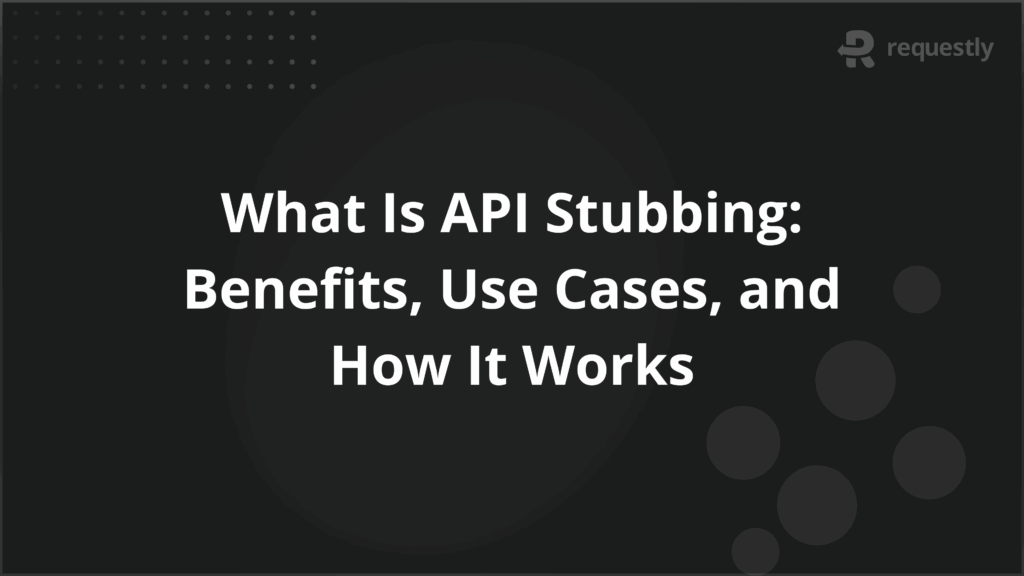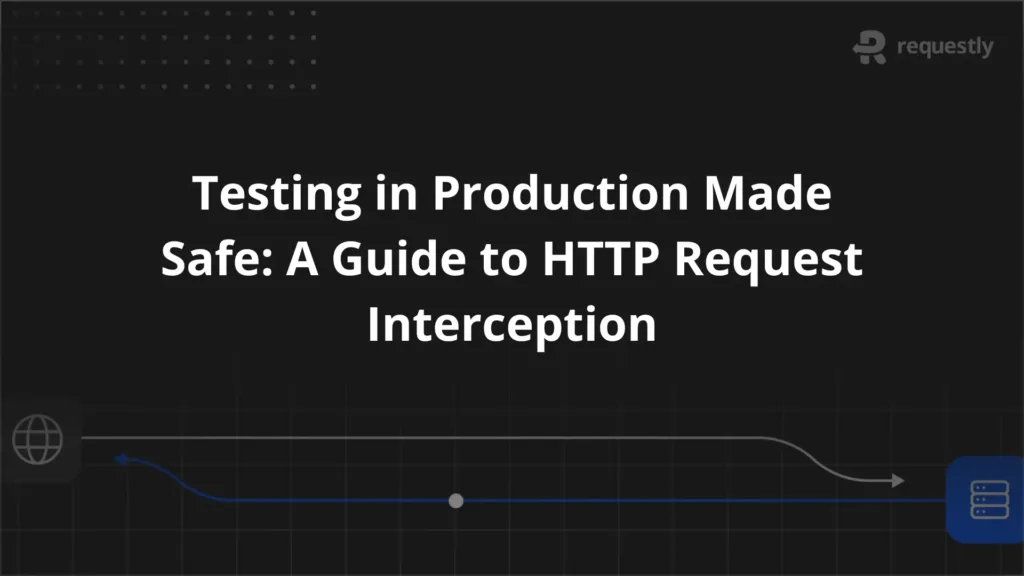What is API Stubbing: Benefits, Use Cases, and How It Works


Modern applications are built on APIs, but calling real external or internal services during development and testing is often impractical. These systems may be unstable, rate-limited, or unavailable, making them unsuitable for reliable test environments.
API stubbing offers a reliable workaround by simulating API behavior in a controlled environment. It allows teams to test against consistent responses without depending on the availability or behavior of actual services.
This article explains what API stubbing is, why and when to use it, and the best practices of it.
What Is API Stubbing?
API stubbing is a testing method where you replace real API calls with predefined, static responses. Instead of calling a live server, your application receives dummy data that mimics the expected behavior. These stubs act as placeholders and do not include any actual business logic.
The goal of stubbing is to simulate known responses in a controlled, repeatable way. This allows you to test how your system behaves under specific conditions without relying on external services.
Stubbing is not the same as mocking. While both are used to replace dependencies during testing, stubs only provide fixed outputs. They do not track how the API is called. Mocks, by contrast, allow you to verify interactions such as the order of calls or the arguments passed. Stubs are better suited for testing outcomes, not for checking how the code interacts with the API.
How API Stubbing Works
API stubbing works by intercepting real API calls and returning predefined responses instead. This lets you simulate different server behaviors without relying on a live backend. Stubbing is typically done using testing frameworks, code libraries, or network interception tools.
There are two common ways to implement stubbing:
- Intercepting HTTP Requests: The tool listens for actual outgoing HTTP requests your code makes, matches the request’s URL, HTTP method, headers, or body, and then returns a predefined response. No data goes over the internet in this step.
- Replacing Dependencies: In some languages and frameworks, you can replace the function, class, or module that calls the real API with your stub implementation. This is common in unit and integration tests.
Example: API Stubbing with Requestly
Imagine your application makes a GET request to /users/42. Using Requestly, you can set up a rule that intercepts this call and returns a custom JSON response, like:
{
"id": 42,
"name": "Alice"
}
This response will be returned instantly during tests, regardless of the actual API status or availability. It helps you test specific scenarios without waiting for the backend to be ready or stable.
How Stubs Help in Testing and Debugging
Stubs introduce several practical benefits for both testing and debugging environments:
- Isolation: Stubs decouple your application’s tests from third-party or unstable services. This isolation ensures you can test features deterministically.
- Speed: Without remote calls, tests run faster and avoid performance bottlenecks.
Reliability: Flaky tests, often caused by unreliable remote APIs or network conditions, are largely eliminated. - Coverage: With stubs, you can simulate error conditions, boundary cases, and edge scenarios that might be rare or costly to replicate against live APIs.
- Debugging: Stubbed APIs simplify debugging by providing predictable responses. This makes problem tracing more direct and avoids confusion when issues stem from external providers rather than your code
When to Use vs When to Avoid API Stubs
Stubs are not always the right choice. Consider these scenarios for and against their use:
When to Use API Stubs
- You need to isolate your component from external systems to focus on your code’s logic and side effects.
- External services are unavailable, slow, or unreliable.
- You want to simulate error scenarios that are hard to trigger with real APIs.
- Team members work in parallel; frontend work shouldn’t wait for backend completion.
- You require fast feedback in CI pipelines.
When to Avoid API Stubs
- You want to test end-to-end behavior, covering full integration with all real downstream dependencies.
- Your tests need to verify real authentication, authorization, or API rate-limiting rules.
- Stubbing would mask integration issues, contract mismatches, or data drift.
- Overuse of stubs leads to code paths unused in real environments, creating false confidence.
Takeaway: Use stubs for unit and integration tests, but always include real API tests in a separate, later stage of your test plan.
API Stubbing in Local vs Shared Environments
The way you manage stubs depends on your testing setup. Both local and shared environments have their own pros and tradeoffs:
Aspect | Local Development | Shared (Staging or Team) Environment |
Where it runs | On the developer’s machine | Centralized stub service or shared configuration |
Speed and flexibility | Fast feedback loop, easy to tweak stub responses | Supports automation and consistency across teams |
Team coordination | No need to sync with others | All team members use the same stub data |
Best suited for | Prototyping, experimentation, isolated development | CI/CD pipelines, shared QA, regression testing |
Potential issues | Stub drift between team members | Needs strict versioning and documentation of stub responses |
Contract accuracy | Must still match the production API contract | Must still match the production API contract |
In both cases, make sure stub responses match the actual contract of the production API. This ensures the system under test does not develop hard dependencies on “happy path only” responses.
Using API Stubs for Feature Flagging and A/B Testing
Feature flagging and A/B testing introduce dynamic behavior based on user segments or feature rollout stages. This can complicate testing, especially when backend support isn’t fully implemented or consistent across environments.
API stubbing helps by simulating different feature states or variants, allowing you to test how your application responds without relying on live backend changes. It removes uncertainty and makes it easier to verify behavior early in the development cycle.
Here’s how stubs help:
- For feature flags: For new features gated behind a flag, stubs can return different payloads based on feature availability or user assignment.
- For A/B testing: You can use stubs to simulate responses for different user groups (e.g., variant A vs. variant B) without waiting for backend experiments to be live.
- For gradual rollouts: Stubs ensure your frontend or API consumers can handle both old and new payloads, helping prevent issues as features roll out in phases.
How Requestly Helps With API Stubbing
Requestly is an open-source tool that intercepts and modifies HTTP requests and responses without requiring changes in the backend. It helps developers and testers simulate realistic API behavior during development.
- Mock or redirect API calls: Create rules to return custom responses or reroute API traffic when the backend is unavailable or incomplete.
- Simulate error and edge cases: Add delays, change status codes, or return malformed data to test how your app handles failures and unusual conditions.
- Customize requests and responses: Modify HTTP headers, request payloads, or response bodies to suit different testing scenarios.
- Use across environments: Apply stubs in-browser or integrate them into automated end-to-end tests.
- Collaborate with shared rules: Share rule sets across teams to ensure consistent behavior in local and shared environments.
Example: API Stubbing with Requestly
To see how Requestly handles API stubbing in practice, let’s walk through a real-world scenario: intercepting a GET /users/42 API call and returning a custom response.
This can be done in two ways — locally for fast iteration or in the cloud for team-wide consistency.
Option 1: Local Stubbing Using “Modify API Response”
Use Requestly’s browser extension or desktop app to intercept and replace API responses directly.
Steps:
1. Open Requestly and create a new Modify API Response rule.
2. Set the rule condition to match the target API call:
URL contains /users/42
3. Define the mock response:
- Status Code: 200
- Content-Type: application/json
- Body:
{
"id": 42,
"name": "Alice",
"role": "tester"
}
Now, when your app sends a request to /users/42, Requestly will intercept it and return this stubbed response instantly and without hitting the backend.
Option 2: Cloud-Based Stubbing Using File Hosting + Redirect
This method lets you use the same mock across different machines or test pipelines.
Steps:
1. Upload a file (user-42.json) to Requestly’s File Server.
Contents:
{
"id": 42,
"name": "Alice",
"role": "tester"
}
2. Create a Redirect Request rule:
- Condition: URL contains /users/42
- Redirect to: the hosted JSON file URL from Requestly
This is ideal for QA, automated tests, or shared dev environments, ensuring everyone gets the same mock data.
Conclusion
API stubbing simulates predictable responses from external systems, helping teams isolate bugs, speed up feedback, and test edge cases without relying on live APIs. When combined with real API tests, stubs bring speed, control, and confidence to your test strategy.
Requestly simplifies API stubbing by removing the need for backend changes or complex setups. Its visual interface, flexible mocking rules, and ability to intercept real traffic help developers and testers simulate scenarios faster. Whether you’re unblocking frontend work or managing shared stubs, Requestly makes the process easier and more efficient.

Contents
- What Is API Stubbing?
- How API Stubbing Works
- How Stubs Help in Testing and Debugging
- When to Use vs When to Avoid API Stubs
- When to Use API Stubs
- When to Avoid API Stubs
- API Stubbing in Local vs Shared Environments
- Using API Stubs for Feature Flagging and A/B Testing
- How Requestly Helps With API Stubbing
- Example: API Stubbing with Requestly
- Conclusion
Subscribe for latest updates
Share this article
Related posts






















